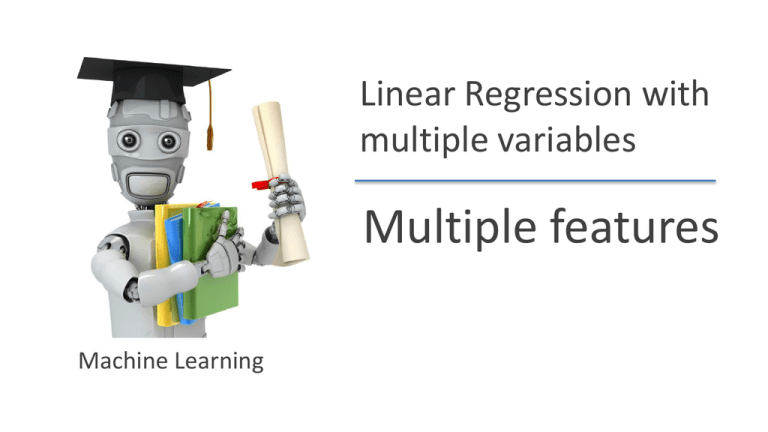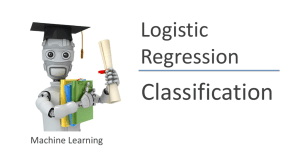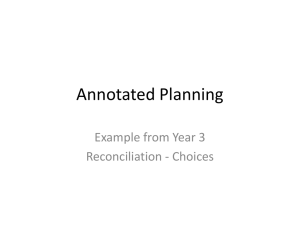Introduction to Programming
advertisement

Linear Regression with multiple variables Multiple features Machine Learning Multiple features (variables). Size (feet2) Price ($1000) 2104 1416 1534 852 … 460 232 315 178 … Andrew Ng Multiple features (variables). Size (feet2) Number of bedrooms Number of floors Age of home (years) Price ($1000) 2104 1416 1534 852 … 5 3 3 2 … 1 2 2 1 … 45 40 30 36 … 460 232 315 178 … Notation: = number of features = input (features) of = value of feature in training example. training example. Andrew Ng Hypothesis: Previously: Andrew Ng For convenience of notation, define . Multivariate linear regression. Andrew Ng Linear Regression with multiple variables Gradient descent for multiple variables Machine Learning Hypothesis: Parameters: Cost function: Gradient descent: Repeat (simultaneously update for every ) Andrew Ng New algorithm Repeat Gradient Descent : Previously (n=1): Repeat (simultaneously update ) (simultaneously update for ) Andrew Ng Linear Regression with multiple variables Gradient descent in practice I: Feature Scaling Machine Learning Feature Scaling Idea: Make sure features are on a similar scale. E.g. = size (0-2000 feet2) = number of bedrooms (1-5) size (feet2) number of bedrooms Andrew Ng Feature Scaling Get every feature into approximately a range. Andrew Ng Mean normalization Replace with (Do not apply to to make features have approximately zero mean ). E.g. Andrew Ng Linear Regression with multiple variables Gradient descent in practice II: Learning rate Machine Learning Gradient descent - “Debugging”: How to make sure gradient descent is working correctly. - How to choose learning rate . Andrew Ng Making sure gradient descent is working correctly. Example automatic convergence test: 0 100 200 300 400 Declare convergence if decreases by less than in one iteration. No. of iterations Andrew Ng Making sure gradient descent is working correctly. Gradient descent not working. Use smaller . No. of iterations No. of iterations - No. of iterations For sufficiently small , should decrease on every iteration. But if is too small, gradient descent can be slow to converge. Andrew Ng Summary: - If is too small: slow convergence. - If is too large: may not decrease on every iteration; may not converge. To choose , try Andrew Ng Linear Regression with multiple variables Features and polynomial regression Machine Learning Housing prices prediction Andrew Ng Polynomial regression Price (y) Size (x) Andrew Ng Choice of features Price (y) Size (x) Andrew Ng Linear Regression with multiple variables Normal equation Machine Learning Gradient Descent Normal equation: Method to solve for analytically. Andrew Ng Intuition: If 1D (for every ) Solve for Andrew Ng Examples: 1 1 1 1 Size (feet2) Number of bedrooms Number of floors Age of home (years) Price ($1000) 2104 1416 1534 852 5 3 3 2 1 2 2 1 45 40 30 36 460 232 315 178 Andrew Ng examples ; features. E.g. If Andrew Ng is inverse of matrix . Octave: pinv(X’*X)*X’*y Andrew Ng training examples, Gradient Descent features. • Need to choose . • Needs many iterations. • Works well even when is large. Normal Equation • No need to choose . • Don’t need to iterate. • Need to compute • Slow if is very large. Andrew Ng Linear Regression with multiple variables Machine Learning Normal equation and non-invertibility (optional) Normal equation - What if degenerate) is non-invertible? (singular/ - Octave: pinv(X’*X)*X’*y Andrew Ng What if is non-invertible? • Redundant features (linearly dependent). E.g. size in feet2 size in m2 • Too many features (e.g. ). - Delete some features, or use regularization. Andrew Ng







